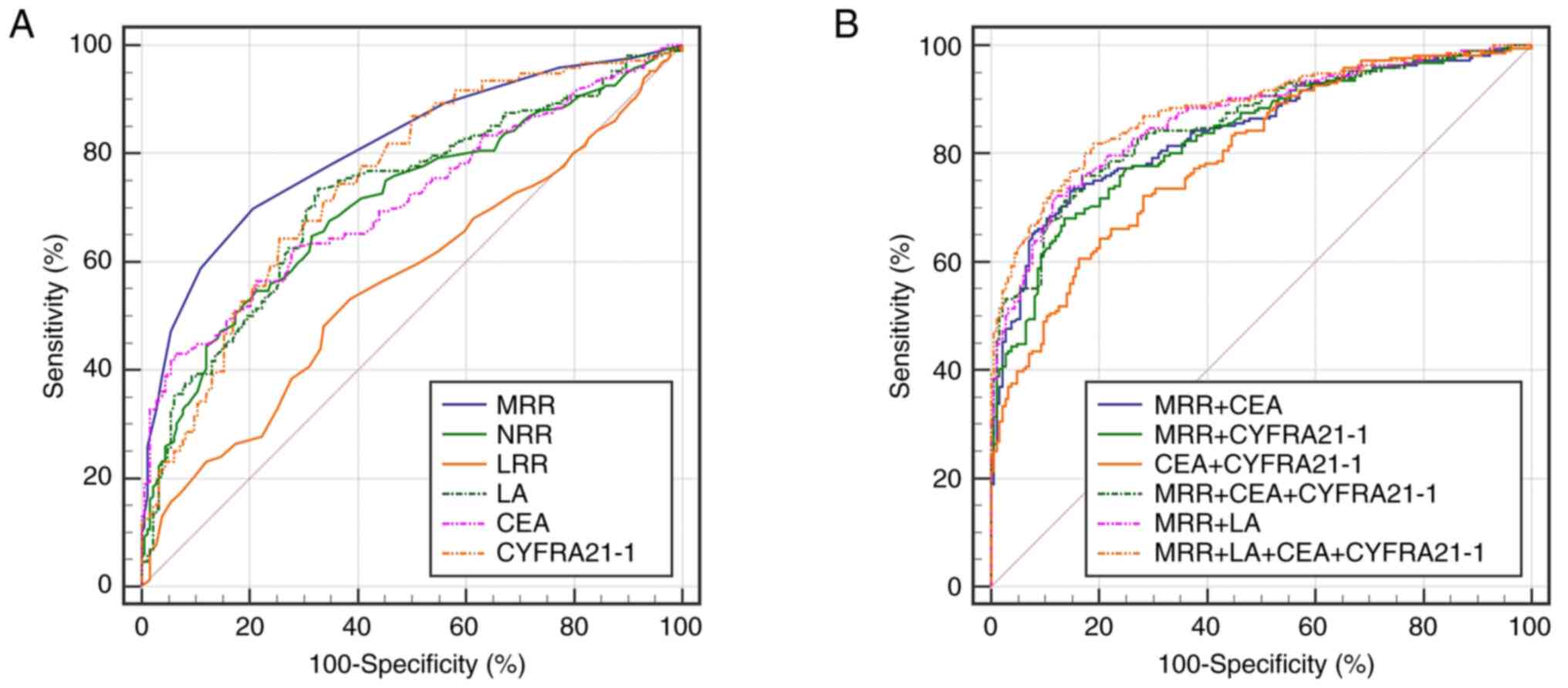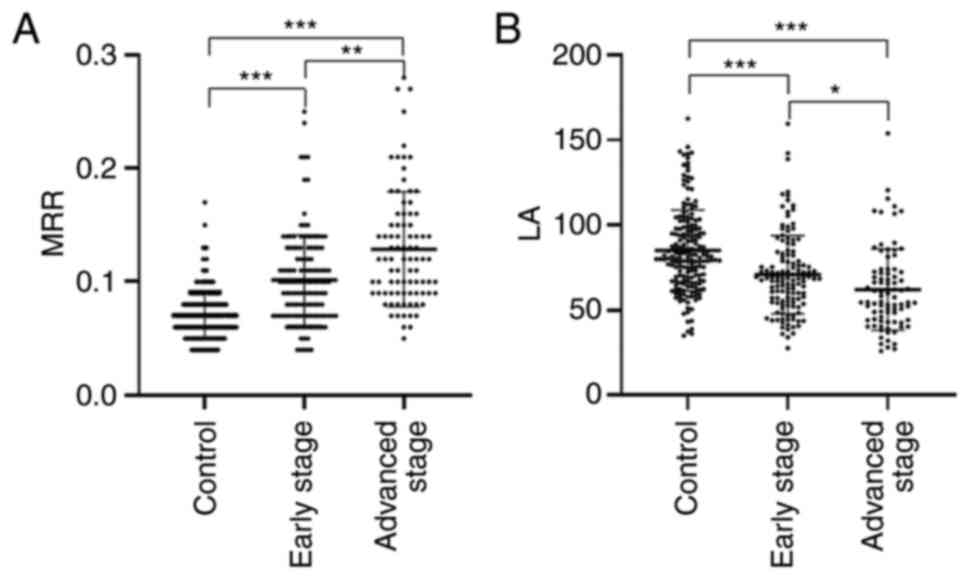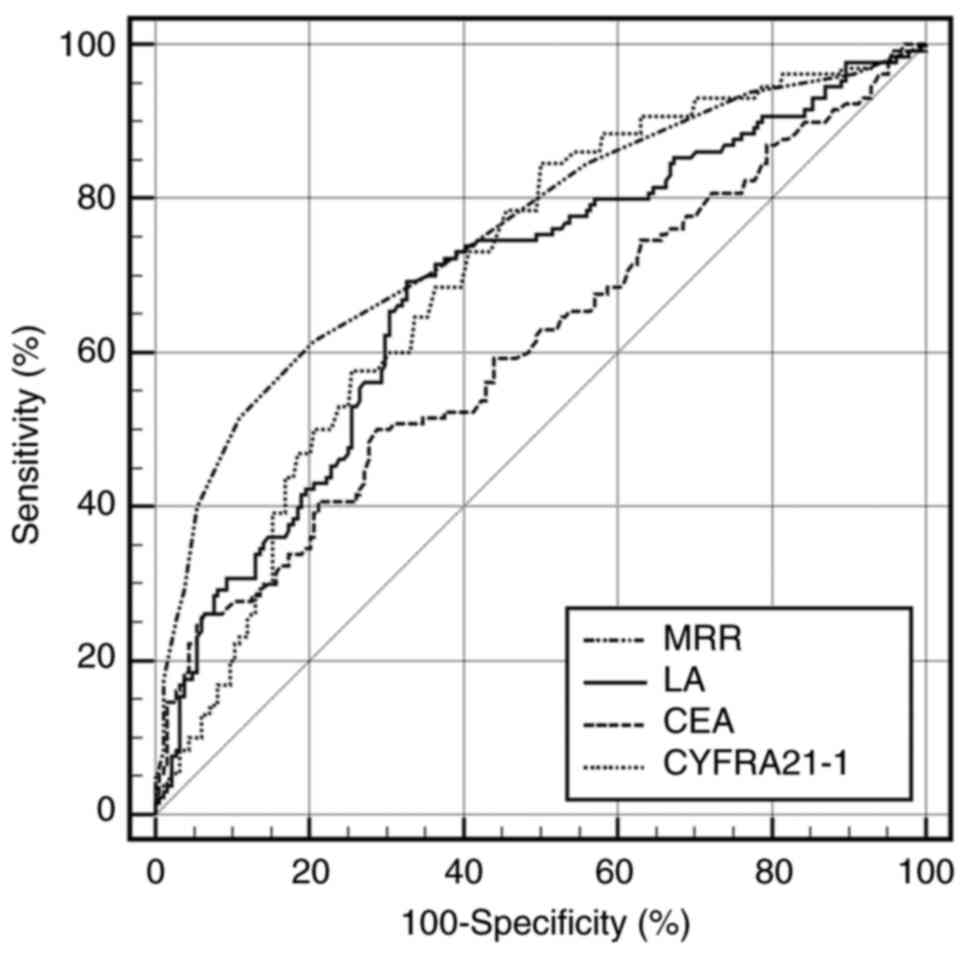|
1
|
Sung H, Ferlay J, Siegel RL, Laversanne M,
Soerjomataram I, Jemal A and Bray F: Global cancer statistics 2020:
GLOBOCAN Estimates of incidence and mortality worldwide for 36
cancers in 185 countries. CA Cancer J Clin. 71:209–249. 2021.
View Article : Google Scholar : PubMed/NCBI
|
|
2
|
Xia C, Dong X, Li H, Cao M, Sun D, He S,
Yang F, Yan X, Zhang S, Li N and Chen W: Cancer statistics in China
and United States, 2022: Profiles, trends, and determinants. Chin
Med J (Engl). 135:584–590. 2022. View Article : Google Scholar : PubMed/NCBI
|
|
3
|
Jonas DE, Reuland DS, Reddy SM, Nagle M,
Clark SD, Weber RP, Enyioha C, Malo TL, Brenner AT, Armstrong C, et
al: Screening for lung cancer with low-dose computed tomography:
Updated evidence report and systematic review for the US preventive
services task force. JAMA. 325:971–987. 2021. View Article : Google Scholar : PubMed/NCBI
|
|
4
|
Grivennikov SI, Greten FR and Karin M:
Immunity, inflammation, and cancer. Cell. 140:883–899. 2010.
View Article : Google Scholar : PubMed/NCBI
|
|
5
|
Chen W, Xin S and Xu B: Value Research of
NLR, PLR, and RDW in prognostic assessment of patients with
colorectal cancer. J Healthc Eng. 2022:79714152022. View Article : Google Scholar : PubMed/NCBI
|
|
6
|
Mandaliya H, Jones M, Oldmeadow C and
Nordman II: Prognostic biomarkers in stage IV non-small cell lung
cancer (NSCLC): Neutrophil to lymphocyte ratio (NLR), lymphocyte to
monocyte ratio (LMR), platelet to lymphocyte ratio (PLR) and
advanced lung cancer inflammation index (ALI). Transl Lung Cancer
Res. 8:886–894. 2019. View Article : Google Scholar : PubMed/NCBI
|
|
7
|
Garrett C, Becker TM, Lynch D, Po J, Xuan
W, Scott KF and de Souza P: Comparison of neutrophil to lymphocyte
ratio and prognostic nutritional index with other clinical and
molecular biomarkers for prediction of glioblastoma multiforme
outcome. PLoS One. 16:e02526142021. View Article : Google Scholar : PubMed/NCBI
|
|
8
|
Jakubowska K, Koda M, Grudzińska M,
Kańczuga-Koda L and Famulski W: Monocyte-to-lymphocyte ratio as a
prognostic factor in peripheral whole blood samples of colorectal
cancer patients. World J Gastroenterol. 26:4639–4655. 2020.
View Article : Google Scholar : PubMed/NCBI
|
|
9
|
Fang T, Wang Y, Yin X, Zhai Z, Zhang Y,
Yang Y, You Q, Li Z, Ma Y, Li C, et al: Diagnostic Sensitivity of
NLR and PLR in early diagnosis of gastric cancer. J Immunol Res.
2020:91460422020. View Article : Google Scholar : PubMed/NCBI
|
|
10
|
Baracos VE, Martin L, Korc M, Guttridge DC
and Fearon KCH: Cancer-associated cachexia. Nat Rev Dis Primers.
4:171052018. View Article : Google Scholar : PubMed/NCBI
|
|
11
|
Zhang Z, Pereira SL, Luo M and Matheson
EM: Evaluation of blood biomarkers associated with risk of
malnutrition in older adults: A systematic review and
meta-analysis. Nutrients. 9:8292017. View Article : Google Scholar : PubMed/NCBI
|
|
12
|
Eckart A, Struja T, Kutz A, Baumgartner A,
Baumgartner T, Zurfluh S, Neeser O, Huber A, Stanga Z, Mueller B
and Schuetz P: Relationship of nutritional status, inflammation,
and serum albumin levels during acute illness: A prospective study.
Am J Med. 133:713–722.e7. 2020. View Article : Google Scholar : PubMed/NCBI
|
|
13
|
Xie H, Wei L, Tang S and Gan J: Prognostic
value of pretreatment albumin-to-alkaline phosphatase ratio in
cancer: A meta-analysis. Biomed Res Int. 2020:66610972020.
View Article : Google Scholar : PubMed/NCBI
|
|
14
|
Yang JR, Xu JY, Chen GC, Yu N, Yang J,
Zeng DX, Gu MJ, Li DP, Zhang YS and Qin LQ: Post-diagnostic
C-reactive protein and albumin predict survival in Chinese patients
with non-small cell lung cancer: A prospective cohort study. Sci
Rep. 9:81432019. View Article : Google Scholar : PubMed/NCBI
|
|
15
|
Wang Y, Wang H, Yin W, Lin Y, Zhou L,
Sheng X, Xu Y, Sha R and Lu J: Novel lymphocyte to red blood cell
ratio (LRR), neutrophil to red blood cell ratio (NRR), monocyte to
red blood cell ratio (MRR) as predictive and prognostic biomarkers
for locally advanced breast cancer. Gland Surg. 8:627–635. 2019.
View Article : Google Scholar : PubMed/NCBI
|
|
16
|
Yamamoto T, Kawada K, Hida K, Matsusue R,
Itatani Y, Mizuno R, Yamaguchi T, Ikai I and Sakai Y: Combination
of lymphocyte count and albumin concentration as a new prognostic
biomarker for rectal cancer. Sci Rep. 11:50272021. View Article : Google Scholar : PubMed/NCBI
|
|
17
|
Detterbeck FC, Boffa DJ, Kim AW and Tanoue
LT: The eighth edition lung cancer stage classification. Chest.
151:193–203. 2017. View Article : Google Scholar : PubMed/NCBI
|
|
18
|
Lang-Lazdunski L: Surgery for nonsmall
cell lung cancer. Eur Respir Rev. 22:382–404. 2013. View Article : Google Scholar : PubMed/NCBI
|
|
19
|
Bograd AJ and Vallières E: Surgery as a
component of multimodality care for known stage IIIA-N2 non-small
cell lung cancer. Semin Respir Crit Care Med. 41:346–353. 2020.
View Article : Google Scholar : PubMed/NCBI
|
|
20
|
Wakeam E, Acuna SA, Leighl NB, Giuliani
ME, Finlayson SRG, Varghese TK and Darling GE: Surgery versus
chemotherapy and radiotherapy for early and locally advanced small
cell lung cancer: A propensity-matched analysis of survival. Lung
Cancer. 109:78–88. 2017. View Article : Google Scholar : PubMed/NCBI
|
|
21
|
Zhang ZH, Han YW, Liang H and Wang LM:
Prognostic value of serum CYFRA21-1 and CEA for non-small-cell lung
cancer. Cancer Med. 4:1633–1638. 2015. View
Article : Google Scholar : PubMed/NCBI
|
|
22
|
Song WA, Liu X, Tian XD, Wang W, Liang CY,
Zhang T, Guo JT, Peng YH and Zhou NK: Utility of squamous cell
carcinoma antigen, carcinoembryonic antigen, Cyfra 21-1 and neuron
specific enolase in lung cancer diagnosis: A prospective study from
China. Chin Med J (Engl). 124:3244–3248. 2011.PubMed/NCBI
|
|
23
|
Giannakeas V, Kotsopoulos J, Cheung MC,
Rosella L, Brooks JD, Lipscombe L, Akbari MR, Austin PC and Narod
SA: Analysis of platelet count and new cancer diagnosis over a
10-year period. JAMA Netw Open. 5:e21416332022. View Article : Google Scholar : PubMed/NCBI
|
|
24
|
Tan Q, Liu S, Liang C, Han X and Shi Y:
Pretreatment hematological markers predict clinical outcome in
cancer patients receiving immune checkpoint inhibitors: A
meta-analysis. Thorac Cancer. 9:1220–1230. 2018. View Article : Google Scholar : PubMed/NCBI
|
|
25
|
Chan SWS, Smith E, Aggarwal R, Balaratnam
K, Chen R, Hueniken K, Fazelzad R, Weiss J, Jiang S, Shepherd FA,
et al: Systemic inflammatory markers of survival in epidermal
growth factor-mutated non-small-cell lung cancer:
Single-institution analysis, systematic review, and meta-analysis.
Clin Lung Cancer. 22:390–407. 2021. View Article : Google Scholar : PubMed/NCBI
|
|
26
|
Peng F, Hu D, Lin X, Chen G, Liang B, Li
C, Chen Y, Cui Z, Zhang H, Lin J, et al: The monocyte to red blood
cell count ratio is a strong predictor of postoperative survival in
colorectal cancer patients: The Fujian prospective investigation of
cancer (FIESTA) study. J Cancer. 8:967–975. 2017. View Article : Google Scholar : PubMed/NCBI
|
|
27
|
Robinson A, Han CZ, Glass CK and Pollard
JW: Monocyte regulation in homeostasis and malignancy. Trends
Immunol. 42:104–119. 2021. View Article : Google Scholar : PubMed/NCBI
|
|
28
|
Wesselius LJ, Wheaton DL, Manahan-Wahl LJ,
Sherard SL, Taylor SA and Abdou NA: Lymphocyte subsets in lung
cancer. Chest. 91:725–729. 1987. View Article : Google Scholar : PubMed/NCBI
|
|
29
|
Wang YY, Zhou N, Liu HS, Gong XL, Zhu R,
Li XY, Sun Z, Zong XH, Li NN, Meng CT, et al: Circulating activated
lymphocyte subsets as potential blood biomarkers of cancer
progression. Cancer Med. 9:5086–5094. 2020. View Article : Google Scholar : PubMed/NCBI
|
|
30
|
Yang Z, Zheng Y, Wu Z, Wen Y, Wang G, Chen
S, Tan F, Li J, Wu S, Dai M, et al: Association between
pre-diagnostic serum albumin and cancer risk: Results from a
prospective population-based study. Cancer Med. 10:4054–4065. 2021.
View Article : Google Scholar : PubMed/NCBI
|
|
31
|
Fiala O, Pesek M, Finek J, Racek J,
Minarik M, Benesova L, Bortlicek Z, Sorejs O, Kucera R and Topolcan
O: Serum albumin is a strong predictor of survival in patients with
advanced-stage non-small cell lung cancer treated with erlotinib.
Neoplasma. 63:471–476. 2016. View Article : Google Scholar : PubMed/NCBI
|
|
32
|
White JV, Guenter P, Jensen G, Malone A
and Schofield M; Academy of Nutrition and Dietetics Malnutrition
Work Group and A.S.P.E.N. Malnutrition Task Force; A.S.P.E.N. Board
of Directors, : Consensus statement of the Academy of Nutrition and
Dietetics/American society for parenteral and enteral nutrition:
Characteristics recommended for the identification and
documentation of adult malnutrition (undernutrition). J Acad Nutr
Diet. 112:730–738. 2012. View Article : Google Scholar : PubMed/NCBI
|
|
33
|
Nagai M, Noguchi R, Takahashi D, Morikawa
T, Koshida K, Komiyama S, Ishihara N, Yamada T, Kawamura YI, Muroi
K, et al: Fasting-Refeeding impacts immune cell dynamics and
mucosal immune responses. Cell. 178:1072–1087.e14. 2019. View Article : Google Scholar : PubMed/NCBI
|
|
34
|
Iyer SS, Chatraw JH, Tan WG, Wherry EJ,
Becker TC, Ahmed R and Kapasi ZF: Protein energy malnutrition
impairs homeostatic proliferation of memory CD8 T cells. J Immunol.
188:77–84. 2012. View Article : Google Scholar : PubMed/NCBI
|

















